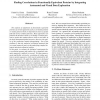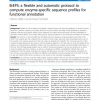311 search results - page 32 / 63 » Statistical significance in biological sequence analysis |
BIBE
2006
IEEE
14 years 1 months ago
2006
IEEE
The analysis of alignments of functionally equivalent proteins can reveal regularities such as correlated positions or residue patterns which are important to ensure a specific f...
HPDC
2010
IEEE
13 years 8 months ago
2010
IEEE
A common task in biological research is to predict function for proteins by comparing sequences between proteins of known and unknown function. This is often done using pair-wise ...
WABI
2010
Springer
13 years 6 months ago
2010
Springer
Quantification of selective pressures on regulatory sequences is a central question in studying the evolution of gene regulatory networks. Previous methods focus primarily on sing...
BMCBI
2010
13 years 5 months ago
2010
Background: Models for the simulation of metabolic networks require the accurate prediction of enzyme function. Based on a genomic sequence, enzymatic functions of gene products a...
ALMOB
2008
13 years 7 months ago
2008
The increasing throughput of sequencing raises growing needs for methods of sequence analysis and comparison on a genomic scale, notably, in connection with phylogenetic tree reco...


